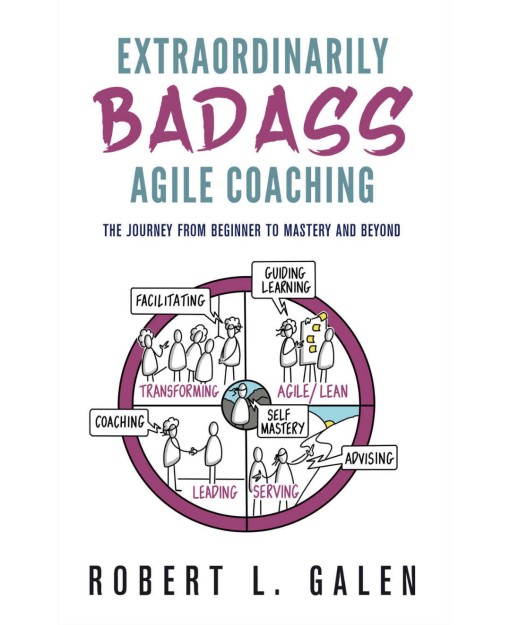
Chapter 7 of Badass Agile Coaching: The Journey from Beginner to Mastery and Beyond introduces The Agile Coaching Wheel and begins the second section of Extraordinary Badass Agile Coaching, which is focused on coaching models and practice.
The Agile Coaching Wheel is a step in codifying the different domains of capability that an agile coach needs to bring to bear in order to be effective and truly badass. There are eight macro competencies ranging from Agile/Lean Practitioner (where principles and methods live) to Transforming (encompassing organizational change and design). Each of the high-level competency areas is further broken down into coaching competencies (two for each area). All of this is anchored by self-mastery and bounded by business domain knowledge. The breath of the Wheel is impressive. Since reading this chapter a few weeks ago, I have pressed the model into action as a tool to discuss areas of growth. I recently asked three new coaches to review the model and then to self-assess their knowledge and capabilities in each of the 16 coaching competencies. I had the coaches assess their skills in the competency areas before a one-on-one coaching session. The goal was to develop a growth plan for each individual and to identify core topics that we could tackle as a group. The coaches simply did not have the bandwidth to step back and think about their skills and knowledge base in a meaningful way. Using this form of the model requires making time for introspection. I have since used the model in individual sessions and larger group workshops to better effect — the key at least in these scenarios was to build in the time for introspection into our interaction rather than to ask them to find the time outside our sessions.
The skill of introspection is not directly mentioned in the Agile Coaching Wheel, however, I would suggest that it is part of self-mastery which sits at the hub of the wheel. Understanding who you are, how you react to triggers, and where you need to grow is not a fluffy idea to be pushed off to the side in order to focus on more technical topics and certifications to place on your LinkedIn headline. Without a solid understanding of yourself, you will be a far less effective coach. Finding time to be introspective is not just important but critical. I find that understanding the need to achieve self-mastery is not well understood by people that are new to agile coaching or are coaching through other roles such as Scrum Master or team lead. Using the model to have a constructive conversation with other coaches (of all stripes) is useful as a self-introspection tool. Every time I walk through the model or a capability with another person, I learn something new about myself.
As an experiment to begin the new year, spend time reading the explanation of each capability and then assess your knowledge and competency on the topic. If you are time-crunched, review one capability area every day for 18 days. When done, discuss your perceptions with your mentor.
Previous Entries in Our Re-read:
Week 1: Logistics and Forewords –
Week 2: Introduction to Badassery in Agile Coaching –
Week 3: The Mindset of the Badass Agile Coach –
Week 4: Agile Coaching Frameworks –
Week 5: Badass Agile Coaching Agreements –
Week 6: Badass Agile Coach Arcs –
Week 7: Badass Agile Coaching Operating System –
Source link
